Finno-Ugric countries
The Finno-Ugric countries are the three independent nation states with a national majority that speaks a Finno-Ugric language: Finland and Estonia, which are inhabited by Baltic Finnic peoples, and Hungary, which is majority Magyar.[1] The three countries are represented in the Finno-Ugric Congress.[2][3] They work together in funding research on Finno-Ugric topics and in protecting the minority rights of other Finno-Ugric-speaking nations that do not occupy sovereign states; collectively these have been called Fenno-Ugria.[4]
Modern entities[edit]
Independent sovereign states[edit]
Balto-Finnic[edit]
| Name | Capital | Founded |
|---|---|---|
| Helsinki | 6 December 1917 | |
| Tallinn | 24 February 1918 |
Ugric[edit]
| Name | Capital | Founded |
|---|---|---|
| Budapest | c. 895 |
Countries where Finno-Ugric languages have official or co-official status[edit]
Saami[edit]
| Name | Capital | Language(s) |
|---|---|---|
| Finland: |
Sajos | Sami |
| Oslo | Sami and Kven | |
| Stockholm | Finnish, Meänkieli and Sami |
The recently extinct Livonian language has special though unofficial status in ![]() Latvia.
Latvia.
Ugric[edit]
| Name | Capital | Language(s) |
|---|---|---|
| Localities with populations over 20% ethnic Hungarian (all in Transylvania) | Hungarian | |
| Serbia: |
Novi Sad | Hungarian |
Permic[edit]
| Name | Capital | Language(s) |
|---|---|---|
| Russia: Template:Country data Komi | Syktyvkar | Komi |
| Russia: |
Izhevsk | Udmurt |
Volgaic[edit]
| Name | Capital | Language(s) |
|---|---|---|
| Russia: |
Yoshkar-Ola | Meadow Mari, Hill Mari |
| Russia: |
Saransk | Erzya, Moksha |
Provinces and autonomous regions without official or co-official status[edit]
| Country | Region | Language(s) | Administrative center | Founded |
|---|---|---|---|---|
| Hungarian | Eisenstadt | 1921 | ||
| Northern Sami | Vadsø | 1576 | ||
| Northern Sami | Tromsø | 1866 | ||
| Sami | Bodø | 17th century | ||
| Southern Sami | Trondheim | 1687 | ||
| Khanty, Mansi | Khanty-Mansiysk | 10 December 1930 | ||
| Komi-Permyak | Perm | 1 December 2005 | ||
| Karelian, Vepsian, Finnish | Petrozavodsk | 16 July 1956 | ||
| Prekmurje | Hungarian | Murska Sobota | Unknown | |
| Meänkieli, Sami | Luleå | 1810 | ||
| Hungarian | Mukacheve | 9 November 1953 |
Historical states and dynasties[edit]
Hungarian states[edit]
| Name | Year(s) | Capital | Map |
|---|---|---|---|
| Hétmagyar confederation | 9th century | Unknown | |
| 895–1000 | Esztergom and Székesfehérvár | ||
| 1000–1301 | Esztergom and Székesfehérvár | 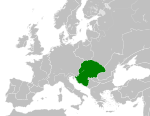
| |
| 1301–1526 | Esztergom, Székesfehérvár and Buda | ||
| Eastern Hungarian Kingdom (vassal under |
1526–1551 1556–1570 |
Buda (1526–41) Lippa (1541–42) Gyulafehérvár (1542–70) |
|
(since 1804 crownland of the |
1526–1867 | Buda (1526–1536, 1784–1873) Pressburg (1536–1783) |

|
(vassal under |
1570–1711 | Gyulafehérvár (1570–1692) Nagyszeben (1692–1711) |

|
| Principality of Upper Hungary (vassal under |
1682–1685 | Kassa | 
|
(since 1804 part of the |
1711–1867 | Nagyszeben (1711–1791, 1848–1861) Kolozsvár (1791–1848, 1861–1867) |

|
| Lands of the Crown of Saint Stephen (part of |
1867–1918 | Budapest | 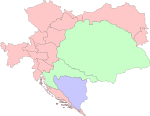
|
Note: some of these countries, while not predominantly ethnically Hungarian, were ruled by Hungarians, so they are considered as such here.
Post-World War I states[edit]
| Name | Year(s) | Capital | Map |
|---|---|---|---|
| 1917–1918 | Obernargen | 
| |
| 1918–1919 | Helsinki | 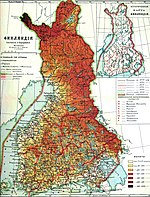
| |
| 1918 | Helsinki | 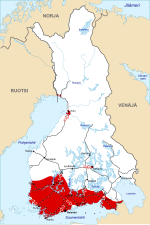
| |
| 1918–40 | Tallinn | 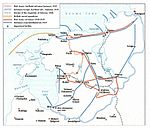
| |
| 1918–1920 | Uhtua | 
| |
| 1918–1919 | Budapest | 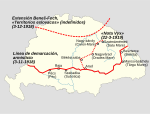
| |
| 1918–1919 | Narva | 
| |
| 1919–1920 | Kirjasalo | 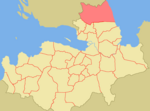
| |
| 1919 | Budapest | 
| |
| 1919–1920 | Budapest | ||
| 1920–1946 | Budapest | 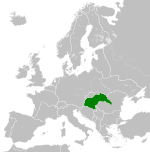
| |
| 1921 | Oberwart | 
| |
| Finnish Democratic Republic | 1939–1940 | Terijoki | 
|
| Template:Country data Second Hungarian Republic | 1946–1949 | Budapest | 
|
| 1949–1989 | Budapest | 
|
Autonomous regions[edit]
| Name | Year(s) | Capital | Map |
|---|---|---|---|
(under Template:Country data Russian Republic) |
1917–1918 | Tallinn | 
|
(under |
1923–1940 1956–1991 |
Petrozavodsk | 
|
(under |
1934–1990 | Saransk | |
(under |
1934–1990 | Izhevsk | |
(under |
1936–1990 | Syktyvkar | |
(under |
1936–1990 | Yoshkar-Ola | |
(under |
1940–1956 | Petrozavodsk | 
|
(under |
1940–1991 | Tallinn | 
|
(under |
1944–1992 | Novi Sad | 
|
| Magyar Autonomous Region (under |
1952–1968 | Târgu Mureș | 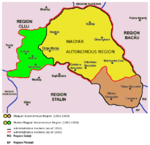
|
(under |
1994–2004 | Shyoltozero |
See also[edit]
References[edit]
- ↑ Korkut, Umut (21 April 2009). "Eager, Pragmatic or Reluctant: Can Common Finno-Ugric Ethnic and Linguistic Links Substantiate Intra-EU CFSP Co-Operation?". SSRN 1392787. Retrieved 20 February 2018 – via papers.ssrn.com.
- ↑ Ruotsala, Helena (20 February 2018). "X Finno-Ugric Congress in Mari El". Ethnologia Fennica. 32: 74–76. Archived from the original on 20 February 2018. Retrieved 20 February 2018 – via journal.fi. Unknown parameter
|url-status=ignored (help) - ↑ "FennoUgria: World Congresses". ftp.eki.ee. Archived from the original on 20 February 2018. Retrieved 20 February 2018. Unknown parameter
|url-status=ignored (help) - ↑ Casen, Marie (30 June 2014). "Udmurt Identity Issues: Core Moments from the Middle Ages to the Present Day". Journal of Ethnology and Folkloristics. 8 (1): 91–110. Archived from the original on 8 March 2018. Retrieved 20 February 2018 – via www.jef.ee. Unknown parameter
|url-status=ignored (help)
| This European geography article is a stub. You can help EverybodyWiki by expanding it. |
This article "Finno-Ugric countries" is from Wikipedia. The list of its authors can be seen in its historical and/or the page Edithistory:Finno-Ugric countries. Articles copied from Draft Namespace on Wikipedia could be seen on the Draft Namespace of Wikipedia and not main one.
